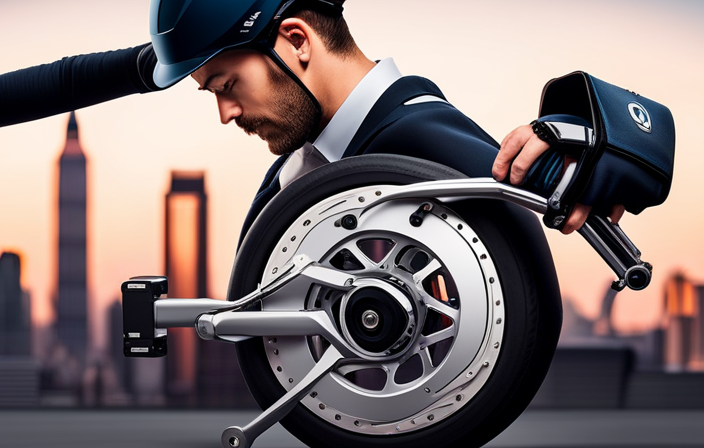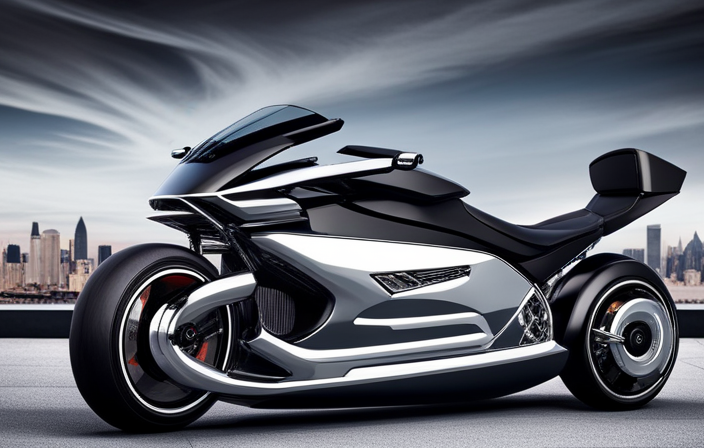There’s an old saying that goes, ‘Knowledge is power.’ And when it comes to understanding the motor hall system in electric bikes, this saying couldn’t be more true.
In this article, we’ll delve into the meaning of a motor hall signal abnormality and explore the causes, symptoms, and steps to diagnose it.
Whether you’re an electric bike enthusiast or simply curious about how these systems work, knowing about motor hall signal abnormalities is crucial for maintaining a smooth and reliable ride.
So let’s dive in and unravel the mysteries of the motor hall system.
Key Takeaways
- Regular maintenance is important to prevent motor hall signal abnormalities on electric bikes.
- Attention to detail and technical knowledge are required for maintaining the motor hall system.
- Cleaning the system regularly helps in removing dirt and debris that can affect the performance.
- If abnormalities are detected, it is advisable to consult a professional for diagnosis and repair.
Understanding the Motor Hall System in Electric Bikes
The motor hall system controls the power and performance of an electric bike. It is a crucial component that helps the bike’s motor function optimally. Understanding the motor hall system is essential for troubleshooting motor hall issues that may arise.
The motor hall system consists of sensors that detect the position and speed of the bike’s motor. These sensors provide vital information to the bike’s controller, allowing it to adjust the power output accordingly. One of the benefits of motor hall technology is its high accuracy in detecting motor position and speed, which leads to smoother and more efficient operation.
Now, let’s delve into what causes a motor hall signal abnormality and how it can be addressed.
What Causes a Motor Hall Signal Abnormality?
One possible cause of a motor hall signal abnormality is a faulty connection. The motor hall system relies on a series of sensors that detect the position of the motor’s rotor. If there is a poor connection between the sensors and the control unit, it can result in a signal abnormality. Common causes of a faulty connection include loose or corroded connectors, damaged wiring, or a defective control unit.
Troubleshooting steps to address this issue include checking and tightening all connections, inspecting the wiring for any signs of damage, and testing the control unit for proper functionality. It is important to address a motor hall signal abnormality promptly, as it can affect the overall performance and efficiency of the electric bike.
Transitioning into the subsequent section, the motor hall system plays a crucial role in ensuring the smooth operation of the electric bike.
Importance of the Motor Hall System in Electric Bikes
Make sure you understand the significance of the motor hall system in your electric bike. The motor hall system plays a crucial role in the proper functioning of your bike’s motor. It consists of sensors that monitor the rotation of the motor’s internal components and provide feedback to the controller. Regular maintenance of the motor hall system is of utmost importance to ensure optimal performance and prevent signal abnormalities. Neglecting this maintenance can lead to various issues, such as decreased power output, erratic behavior, and even motor failure. To emphasize the importance of regular maintenance, let me share a table that highlights the potential consequences of neglecting the motor hall system.
| Neglected Maintenance | Consequences |
|---|---|
| Dirt and debris buildup | Reduced sensor accuracy |
| Loose connections | Intermittent signal disruptions |
| Worn-out sensors | Erratic motor behavior |
| Lack of calibration | Complete motor failure |
Understanding the importance of regular maintenance, let’s now discuss the common symptoms of a motor hall signal abnormality.
Common Symptoms of a Motor Hall Signal Abnormality
If you notice unusual behavior or performance issues with your e-bike, it could be a sign of a motor hall signal abnormality. This is a common problem that can affect the functionality of your electric bike.
To help you identify if you are experiencing motor hall signal issues, here are three common symptoms to look out for:
-
Inconsistent motor assistance: If you feel like your e-bike is providing inconsistent levels of assistance or if it suddenly stops providing any assistance at all, it could be due to a motor hall signal abnormality.
-
Jerky or erratic motor behavior: A motor hall signal abnormality may cause your electric bike’s motor to behave in a jerky or erratic manner, making your ride uncomfortable and less enjoyable.
-
Sudden changes in power output: If you notice sudden changes in the power output of your e-bike, such as a significant increase or decrease in speed without any input from you, it could be a result of a motor hall signal abnormality.
To troubleshoot these issues and diagnose a motor hall signal abnormality, follow the steps in the subsequent section.
Steps to Diagnose a Motor Hall Signal Abnormality
To diagnose a motor hall signal abnormality, you can follow a series of steps to troubleshoot the issue.
Start by checking the connections between the motor and the controller to ensure they are secure and properly aligned. If the connections are fine, the next step is to test the motor hall sensors using a multimeter. This will help determine if the sensors are functioning correctly or if they need to be replaced.
Additionally, inspect the wiring for any damage or loose connections, as this can also cause signal abnormalities. Once you have identified the issue, you can then proceed to troubleshoot and resolve the motor hall signal abnormality.
By diagnosing motor hall signal issues and troubleshooting motor hall signal problems, you can ensure that your electric bike is running smoothly and efficiently.
In the next section, we will discuss some troubleshooting tips for resolving a motor hall signal abnormality.
Troubleshooting Tips for Resolving a Motor Hall Signal Abnormality
One way to resolve a motor hall signal abnormality is by troubleshooting the issue. When diagnosing motor hall signal issues, it is important to follow a systematic approach to identify and resolve the problem. Here are some troubleshooting tips for resolving a motor hall signal abnormality:
-
Check the wiring connections: Ensure that all the connections between the motor hall sensor and the controller are secure and properly connected.
-
Inspect the sensor: Examine the motor hall sensor for any physical damage or loose connections. Replace it if necessary.
-
Test the sensor output: Use a multimeter to measure the voltage output of the motor hall sensor. Compare the readings with the manufacturer’s specifications to determine if it is functioning correctly.
-
Verify the controller settings: Make sure that the controller settings are configured correctly for the motor hall sensor type being used.
By following these troubleshooting steps, you can often identify and resolve motor hall signal abnormality issues on your electric bike. If the problem persists, it may be necessary to seek professional help to further diagnose and address the issue.
When to Seek Professional Help for a Motor Hall Signal Abnormality
Seeking professional help is advisable when experiencing issues with the motor hall signal. While there are troubleshooting techniques that can be attempted, it is important to understand the complexity of the motor hall signal system on an electric bike.
A professional technician will have the knowledge and expertise to diagnose and resolve any abnormalities with the motor hall signal. They can accurately identify the root cause of the problem and provide appropriate solutions. Additionally, they may have access to specialized tools and equipment that are necessary for proper diagnosis and repair.
It is always better to seek professional advice rather than attempting to fix the issue yourself, as incorrect repairs could potentially cause further damage to the electric bike.
Transitioning into the subsequent section, preventive measures can help avoid motor hall signal abnormalities.
Preventive Measures to Avoid Motor Hall Signal Abnormalities
You can avoid motor hall signal abnormalities by taking preventive measures. Here are some preventive maintenance techniques to keep your electric bike running smoothly:
- Regularly clean and inspect the motor hall sensors to ensure they are free from debris and properly aligned.
- Check the wiring connections of the motor hall system for any loose or damaged wires. Secure or replace them as necessary.
- Keep your electric bike protected from extreme weather conditions, as moisture and excessive heat can affect the motor hall signal.
By following these troubleshooting techniques and performing regular preventive maintenance, you can minimize the risk of motor hall signal abnormalities.
In the next section, we will discuss maintenance tips for the motor hall system in electric bikes, which will further help you ensure the smooth operation of your bike’s motor hall system.
Maintenance Tips for the Motor Hall System in Electric Bikes
To ensure the smooth operation of the motor hall system in electric bikes, it is important to regularly maintain and inspect its components. Motor hall maintenance plays a crucial role in preventing signal abnormalities and ensuring optimal performance.
Firstly, it is essential to keep the motor hall sensors clean and free from any debris or dirt that could interfere with their functionality. Regularly inspecting the wiring connections and ensuring they are secure can also help in troubleshooting motor hall issues.
Additionally, checking the voltage output of the motor hall system using a multimeter can detect any potential faults. If abnormalities are detected, it is recommended to consult a professional for further diagnosis and repair.
By following these maintenance tips, electric bike riders can enjoy a smooth ride with a healthy motor hall system, leading to a more enjoyable and efficient biking experience.
Conclusion: Ensuring a Smooth Ride with a Healthy Motor Hall System
In order to have a smooth ride with a healthy motor hall system, it’s important to regularly maintain and inspect its components.
Ensuring a smooth ride and maintaining a healthy motor hall system requires attention to detail and technical knowledge.
Start by regularly cleaning the motor hall system to remove any dirt or debris that may affect its performance.
Check the wiring connections to ensure they are secure and free from any damage.
It’s also important to regularly lubricate the moving parts of the motor hall system to reduce friction and extend its lifespan.
Monitor the motor hall signal for any abnormalities, as this could indicate a potential issue that needs to be addressed.
By following these maintenance tips, you can ensure a smooth ride and prolong the life of your electric bike’s motor hall system.
Frequently Asked Questions
How does the motor hall system in electric bikes work?
The motor hall system in electric bikes consists of components such as sensors and magnets. It measures the position and speed of the motor to ensure proper functioning. Troubleshooting involves checking the wiring, connections, and sensor alignment for any issues.
Can a motor hall signal abnormality cause damage to other parts of the electric bike?
A motor hall signal abnormality can have a significant impact on an electric bike. It can lead to motor failure and potentially damage other parts of the bike, requiring extensive troubleshooting and repairs.
Are there any warning signs before a motor hall signal abnormality occurs?
Before a motor hall signal abnormality occurs, warning signs may include sudden loss of power, jerky acceleration, or strange noises. Troubleshooting motor hall signal abnormalities involves checking connections, inspecting wiring, and testing the hall sensors for proper functioning.
Can a motor hall signal abnormality be fixed without professional help?
Yes, a motor hall signal abnormality can sometimes be fixed without professional help. Motor hall signal troubleshooting is a complex process, but common causes of abnormalities include loose connections, damaged sensors, or faulty wiring.
What are some common maintenance practices to keep the motor hall system healthy?
To maintain a healthy motor hall system on an electric bike, I recommend regular cleaning and lubrication of the motor components, checking and adjusting the hall sensors, and ensuring proper electrical connections and wiring.
Conclusion
In conclusion, maintaining a healthy motor hall system is crucial for a smooth and efficient ride on an electric bike. By understanding the motor hall system and the causes of signal abnormalities, we can take preventive measures to avoid such issues.
Regular diagnosis and maintenance of the motor hall system are essential to identify and address any abnormalities. If necessary, seeking professional help ensures a thorough and accurate resolution.
So, remember to prioritize the health of your motor hall system to enjoy a seamless and enjoyable biking experience.









